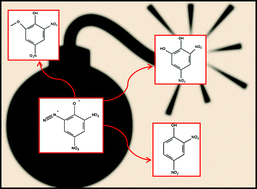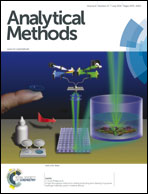Degradation study of nitroaromatic explosives 2-diazo-4,6-dinitrophenol and picramic acid using HPLC and UHPLC-ESI-MS/MS
Abstract
A new and fast HPLC method with UV detection was developed and validated for the simultaneous determination of nitroaromatic explosives diazodinitrophenol (DDNP), the raw material picramic acid (PicA) and three degradation products of DDNP. DDNP and PicA were subjected to forced degradation. DDNP was found to be stable under acidic and basic conditions, while thermal, oxidative and photolytic decomposition resulted in three degradation products. Degradation products were separated from DDNP using Ascentis® Express C18 fused core particle column and subsequently characterised using UHPLC-ESI-MS/MS method. Optimal chromatography was performed using the isocratic elution of mobile phase consisting of acetonitrile–orthophosphoric acid 0.085% 30 : 70 (v/v) pumped at a flow rate of 0.8 mL min−1 at a temperature of 50 °C. System suitability test parameters, linearity and precision of the HPLC method were evaluated. The new HPLC method is suitable for a fast determination of DDNP and degradation products in various samples. Our work provides a basic view on the stability and aspects of degradation process of nitroaromatics DDNP and PicA, and shows the formation of degradation products.


 Please wait while we load your content...
Please wait while we load your content...